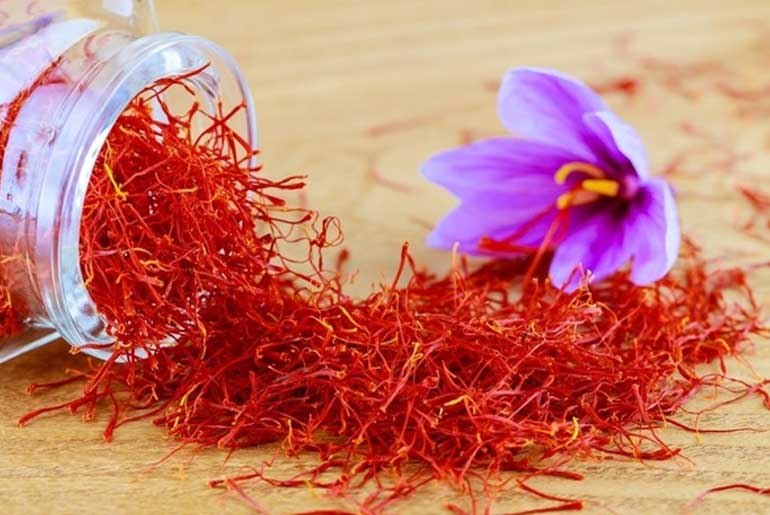Saffron, often referred to as “red gold,” is an exquisite and highly valuable spice with a rich history. It has been cherished for thousands of years for its culinary, cultural, and medicinal significance. Saffron’s delicate red threads not only add flavor and color to dishes but also carry a multitude of potential health benefits. This precious spice is known for its anti-inflammatory, anti-atherosclerotic, antigenotoxic, and cytotoxic properties, making it valuable in the treatment of various disorders. Saffron is rich in antioxidants, helping the body combat oxidative stress, and its delightful fragrance can uplift mood and alleviate symptoms of depression and mood disorders. Additionally, saffron is believed to support cardiovascular health by potentially lowering blood pressure and reducing cholesterol levels. Its extensive history and versatility in both the kitchen and traditional medicine make saffron a truly remarkable and treasured spice.
Saffron’s versatility extends from its use in various dishes to its role in religious ceremonies, where its vibrant color symbolizes purity and auspiciousness. The scientific research highlighting its potential health benefits further elevates its status. Saffron’s ability to address cardiovascular issues, hypertension, stomach disorders, dysmenorrhea, and cognitive impairments underscores its importance in holistic well-being. Whether in culinary creations or holistic health practices, saffron remains an enduring symbol of luxury, flavor, and potential healing properties, earning its reputation as one of the world’s most valuable and cherished spices.
Benefits of saffron:
Saffron is indeed a remarkable spice with a wide range of potential health benefit. Here’s a brief summary of the key advantages associated with saffron:
1. Antioxidant Properties:
Saffron is rich in antioxidants that help combat oxidative stress and free radicals in the body, contributing to overall health and well-being.
2. Anti-Inflammatory Effects:
Research suggests that saffron may possess anti-inflammatory properties, which can be valuable for managing conditions related to inflammation.
3. Mood Enhancement:
Saffron has a traditional use for alleviating mood disorders, and some studies indicate its potential as an antidepressant and mood enhancer.
4. Improved Cognitive Function:
Preliminary research shows that saffron may support cognitive function, potentially enhancing memory and learning abilities.
5. Eye Health:
Saffron’s antioxidants, particularly crocin, may help protect the eyes and are being studied for their potential in preventing age-related macular degeneration.
6. Menstrual Symptom Relief:
Saffron may offer relief from symptoms associated with premenstrual syndrome (PMS) and menstrual pain (dysmenorrhea).
7. Aphrodisiac Properties:
Traditionally considered an aphrodisiac, saffron is believed to have properties that can enhance libido and sexual function.
8. Anticancer Potential:
While more research is needed, some studies suggest that saffron may have potential anticancer properties, potentially inhibiting the growth of cancer cells.
9. Blood Sugar Regulation:
Saffron is being explored for its potential role in regulating blood sugar levels, which could benefit individuals with diabetes or those at risk of developing the condition.
10. Cardiovascular Health:
Saffron may contribute to cardiovascular well-being by potentially lowering blood pressure, reducing cholesterol levels, and improving overall heart health.
11. Antibacterial Properties:
Saffron has been studied for its antibacterial properties, which can help combat certain bacterial infections.
12. Digestive Health:
Saffron has a traditional use in promoting digestive health, providing relief from gastrointestinal discomfort and soothing the digestive tract.
It’s important to note that while saffron shows promise in these areas, further research is needed to establish the full extent of its benefits and the optimal dosages for specific health conditions. If you’re considering using saffron for its potential health advantages, it’s advisable to consult with a healthcare professional to ensure safe and effective utilization.
In ancient times:
In ancient times, saffron was a highly prized and versatile spice that was used for both culinary and medicinal purposes across various cultures. Ancient civilizations, including Persia and the Roman Empire, incorporated saffron to flavor and color a wide range of dishes, from rice and bread to meats and sweets. Furthermore, in Ayurveda and traditional Chinese medicine, saffron was employed as a remedy for digestive problems, respiratory ailments, and mood disorders, highlighting its diverse therapeutic applications. Saffron also held symbolic significance in religious ceremonies and rituals, signifying purity and auspiciousness, further underlining its cultural and historical importance.
Saffron has a rich history of use in various aspects of human life, including:
- Beverages: Saffron was often used to enhance the flavor and color of beverages. It was added to teas, wines, and other infusions, creating aromatic and visually appealing drinks.
- Medicinal Preparations: In ancient medicine systems, including Ayurveda and traditional Chinese medicine, saffron was valued for its potential medicinal properties. It was used in various medicinal preparations to address conditions such as digestive issues, respiratory ailments, and mood disorders.
- Cosmetic and Perfume Production: Saffron was utilized in the production of cosmetics and perfumes. Its distinctive fragrance and vibrant color made it a popular choice for perfumes, oils, and ointments.
- Religious and Ritualistic Use: Saffron had symbolic significance in religious ceremonies and rituals. It was sometimes used as an offering in religious practices, and its vibrant color was associated with purity and auspiciousness.
- Dyeing Fabrics: The natural coloring properties of saffron made it valuable for dyeing fabrics. It was used to impart a golden-yellow hue to textiles, creating luxurious and highly prized fabrics.
- Ancient Recipes: Ancient recipe books and culinary texts often featured saffron as a key ingredient in various dishes. For example, in ancient Rome, saffron was used in recipes for both savory and sweet dishes.
- Preserving Foods: Saffron was also employed for its preservative properties. In the absence of modern refrigeration methods, the antimicrobial properties of saffron were utilized to help preserve certain foods.
- Trade and Exchange: Saffron was a valuable commodity in ancient trade routes. It was exchanged along the Silk Road and other trade routes, contributing to the spice’s widespread use and cultural significance.
These diverse uses of saffron demonstrate its importance in various aspects of human culture and history, from culinary traditions to religious rituals and trade networks.
Add saffron to the diet for health benefits:
Incorporating saffron into your diet can not only add a unique and aromatic flavor but also potentially offer some health benefits. Here are various ways to enjoy saffron in your meals:
- Saffron Infusion: Create a saffron infusion by steeping a few saffron strands in hot water or milk. This saffron-infused liquid can be used in teas, coffees, or added to various recipes.
- Risottos and Pilafs: Saffron is a classic ingredient in risottos and pilafs. Infuse a few saffron strands in warm broth or water and add it to the rice during cooking for both flavor and a beautiful golden color.
- Soups and Stews: Enhance the flavor and visual appeal of soups and stews by dissolving saffron in a bit of warm liquid before incorporating it into the dish.
- Baking: Add saffron to baked goods such as bread, muffins, or cakes. You can infuse it in a small amount of liquid and mix it into the batter for a unique flavor profile.
- Saffron Tea: Prepare a simple saffron tea by infusing saffron strands in hot water. You can enhance the flavor by adding a touch of honey or lemon.
- Desserts: Saffron pairs well with desserts. Add saffron to custards, puddings, ice creams, or sprinkle it on top of desserts to create a visually appealing and aromatic treat.
- Saffron Milk: Warm milk and add a few strands of saffron to create comforting and aromatic saffron milk. This is a popular and traditional way of consuming saffron.
- Yogurt or Lassi: Mix saffron into yogurt or lassi for a unique and flavorful twist. It adds both color and a subtle taste to these dairy-based foods.
- Seafood Dishes: Saffron complements seafood dishes well. Add it to paellas, seafood stews, or grilled fish for a Mediterranean touch.
- Herbal Teas and Infusions: Combine saffron with other herbs and spices to create herbal teas or infusions. This can be a delightful way to enjoy its flavor along with other herbal benefits.
- Saffron Rice: Infuse saffron in warm water and mix it into cooked rice for a vibrant and aromatic saffron rice. This pairs well with a variety of main dishes.
- Curries and Sauces: Incorporate saffron into curry dishes or creamy sauces for both flavor and color. It can add a subtle depth to the overall taste.
When using saffron, remember that a little goes a long way, as it has a strong and distinctive flavor. Experiment with these culinary applications to find the ones that suit your taste and dietary preferences while reaping the potential health benefits of saffron.
Who Should Avoid saffron?
people who should exercise caution or avoid saffron consumption. It’s essential to be aware of potential interactions and side effects associated with saffron, even though it is generally considered safe when consumed in moderate amounts. Here’s a summary of the considerations for each group:
- Pregnant women: Pregnant women should avoid excessive saffron consumption due to its potential to stimulate uterine contractions, which can lead to preterm labor. Consulting with a healthcare provider is advisable.
- Individuals with allergies: Some individuals may be allergic to saffron, so it’s essential to avoid it if you have a known allergy to saffron or related plants.
- People with bipolar disorder: Saffron’s mood-enhancing effects may interact with medications used to manage bipolar disorder. Caution is advised.
- People with low blood pressure: Saffron may have blood pressure-regulating effects, and those with already low blood pressure should use it cautiously to avoid further lowering blood pressure.
- Individuals with hormone-sensitive conditions: Saffron’s estrogen-like effects may affect those with hormone-sensitive conditions like certain types of cancer or uterine fibroids. Consultation with a healthcare provider is recommended.
- People with gastrointestinal issues: Saffron may cause gastrointestinal discomfort or exacerbate digestive problems in some individuals, so those with pre-existing gastrointestinal conditions should monitor their response.
- Individuals with bleeding disorders: Saffron has mild anticoagulant properties, and people with bleeding disorders or those taking blood-thinning medications should consult with a healthcare provider before using saffron.
- Children and infants: Saffron should be introduced cautiously to children and infants, especially if it’s a new food in their diet. Guidance from healthcare professionals is advisable.
- Individuals undergoing surgery: Saffron’s potential blood-thinning effects make it important for those scheduled for surgery to discontinue saffron consumption several weeks before the procedure to reduce bleeding risks.
It’s important to note that saffron, when used in cooking as a spice, is generally considered safe for most people. However, in cases where it’s being used medicinally or in high quantities, these precautions become more significant. Consulting with a healthcare professional is a wise step if you have any concerns about saffron’s safety for your specific situation.
Facts about saffron:
Saffron is indeed a fascinating spice with a rich history and many unique characteristics. Here are some more interesting facts about saffron:
- Culinary Uses: Saffron is highly prized in the culinary world for its distinctive flavor and vibrant color. It’s a key ingredient in many dishes, such as paella, risotto, and biryani, and is used to impart a rich, aromatic taste and a beautiful golden hue.
- Medicinal Properties: Saffron has been used in traditional medicine for centuries. It is believed to have various health benefits, including being an antioxidant, an anti-depressant, and having anti-inflammatory properties. However, it’s essential to use saffron in moderation, as excessive consumption can be harmful.
- Geographical Origin: The majority of saffron production comes from Iran, which is known for producing high-quality saffron. Other countries like India, Spain, and Greece also cultivate saffron, but Iranian saffron is particularly renowned for its quality.
- Saffron’s Color-Enhancing Abilities: Saffron’s vibrant red-orange color can be used to dye fabrics and textiles. It’s also used in traditional arts and crafts to create intricate designs and patterns.
- Saffron’s Unique Flavor: Saffron has a complex flavor profile with hints of floral, honey, and earthy notes. It’s often described as having a slightly sweet and slightly bitter taste, which makes it a versatile spice for both sweet and savory dishes.
- Saffron as a Natural Dye: Beyond culinary and decorative uses, saffron has been employed as a natural dye for clothing and textiles. It can produce various shades of yellow, orange, and red, depending on the concentration and method of application.
- Saffron Production Season: Saffron flowers bloom for only a short period each year, typically in the autumn. This limited blooming season adds to the challenges of saffron cultivation and contributes to its rarity and cost.
- Saffron Adulteration: Due to its high value, saffron is sometimes adulterated with other substances to increase its weight or bulk. This makes it important for consumers to purchase saffron from reputable sources to ensure its purity.
- Saffron Threads’ Sensitivity to Light: Saffron threads are sensitive to light, and exposure to direct sunlight can degrade their quality. To preserve saffron’s flavor and color, it’s often stored in a cool, dark place in airtight containers.
Saffron’s unique characteristics, historical significance, and various uses make it a truly remarkable spice that has fascinated people for centuries.
Disclaimer:
The information contained in this article is for educational and informational purposes only and is not intended as a health advice. We would ask you to consult a qualified professional or medical expert to gain additional knowledge before you choose to consume any product or perform any exercise.









